|
It sounded like an interesting challenge - inviting amateurs to break the Lorenz code before the rebuilt Colossus Mk II at Bletchley Park.
It's a long story. The story of the wartime code breakers at Bletchley Park near Milton Keynes began to emerge in the 1970s. Since then, most people have heard of the Enigma encryption system and the story of how it was broken. Less known is the more sophisticated Lorenz SZ 40 and SZ 42 teleprinter cipher machines. They worked on similar principles but the enciphering was far more complex, using twelve code wheels instead of Enigma's three.
To decipher the Lorenz codes, ten machines known as Colossus Mk ll were built in conditions of great secrecy. Having served their purpose well, in the early 60s the last of the original machines were dismantled and the engineering drawings and notes were burned to keep their existence a secret. All that remained were eight non-technical photographs and some fragments of circuit diagram.
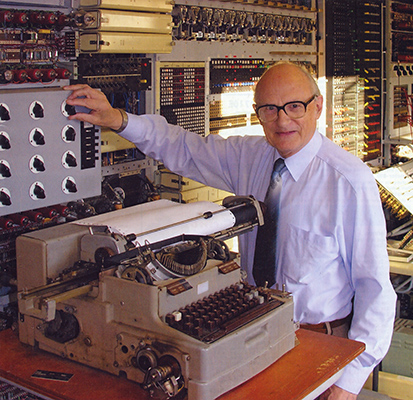
Tony Sale - The man behind the rebuild.
In the late 1980s, Science Museum official Tony Sale was researching the earliest days of computing and came across brief references to Colossus. By 1993 he had gathered all the available information and embarked on the marathon rebuild project at Bletchley Park. With determination, help from some of the original designers and many other people - not to mention a lot of sheer hard work - the rebuilt machine took shape and a partially complete version was switched on by HRH the Duke of Kent on 6 June 1996. After a lot more hard work the Colossus Mk ll rebuild was finally finished, and now forms the centrepiece of the National Museum of Computing at Bletchley Park.
The Cipher Challenge
To celebrate completion of the rebuild, a Cipher Challenge was organised for 15 and 16 November 2008. Three texts were enciphered at Paderborn, Germany, using an SZ 42 machine, and transmitted by DL0HNF at the Heinz Nixdorf Museum Forum, the largest computer museum in Europe. These messages were to be received at Bletchley Park and then fed into Colossus for decoding. Amateurs were also invited to try and beat Colossus at its own game. l went to Bletchley to see this happen.
Seeing it in Action
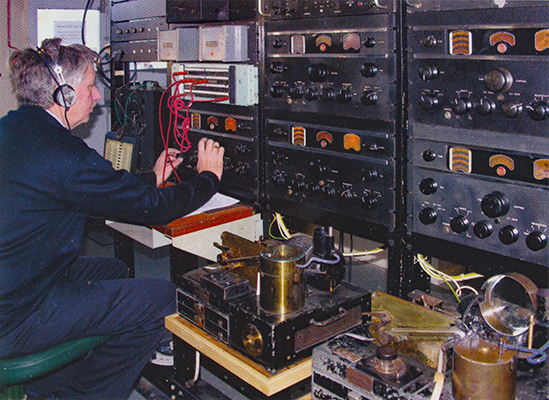
John Pether, G4JGG, operates the replica 'Y' (intercept) station set up to receive the transmissions. Note the fine array of vintage AR88s and the rarely seen undulators (foreground).
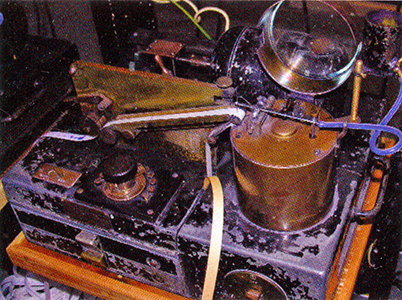
Pen recorders called undulators were used to record the received signal on paper tape.
As l entered the building at Bletchley Park, the first thing I saw was John, G4JGG, operating a replica 'Y' (interception) station with an impressive array of vintage AR88 receivers. These were connected to a pair of 'undulators', pen recorders that record the RTTY marks and spaces onto a paper tape. These were then interpreted and typed into a teleprinter to produce a punched tape that is passed to Colossus.
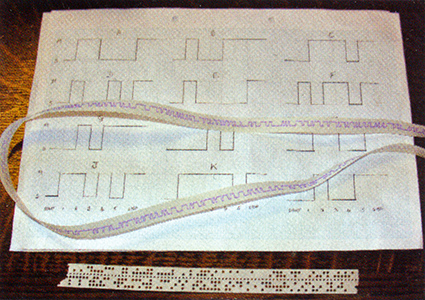
Unduiator tape (known as 'slip') was visually interpreted by Wrens according to recognition charts and then punched onto paper tape. Training took 2-3 months.
The sense of history was almost palpable as John adjusted the AR88s for best signal. Every hour, on the hour, the transmissions from Paderborn drifted in and out of the noise. The RTTY had a strangely musical lilt to it. It was recognisable by ear as 50 baud RTTY, but it used a 360Hz shift and six tones, three simultaneous tones for mark and three for space. The reason for this historically accurate scheme was to give some degree of resistance to selective fading on the AM transmissions in use at the time. It sounded like RTTY played on an harmonica.
At the German end, the message was fed into a conventional teleprinter, the output of which was a conventional plain text RTTY data stream. This was passed to the Lorenz cipher machine to be enciphered before transmission. The resultant output stream contained many control characters (Figures, Carriage Return etc) which would confuse conventional software or teleprinters. This is why the incoming data was recorded on undulators and then visually interpreted and manually typed out on a teleprinter to produce the necessary punched paper tape.
And Now Colossus
It is very hard to describe my feelings as I first walked into the room which contained the rebuilt Colossus Mk ll. The most obvious thing was a strange contraption with fast-spinning wheels and paper tape whizzing through its internals. Nearby was a typewriter on a high stand, and arrays of switches, plugboards and relays. But Colossus itself was an awesome sight. There were two bays of racks, about 7'6 (2.3m) high and 16' (5.5m) wide, with the tape reader tagged on at the end. The circuits were on metal plates bolted to the racks and the valve holders were surface mounted with tag strips for the components. The machine seemed to have a life of its own. It was warm, thanks to around 2,500 valves which dissipated around 5 kW of heat. It even had its own 'heartbeatb, as relays synchronously clicked over every second or so.
When the original machine was suggested, great concern was raised about the likely (un)reliability of that number of valves. However the designer, Tommy Flowers, knew that valves usually fail at switch-on, so his solution was simply to ensure the machines were never switched off! The modern rebuild doesnbt have this luxury, so the filaments are brought up very slowly on a variac.
The Challenge
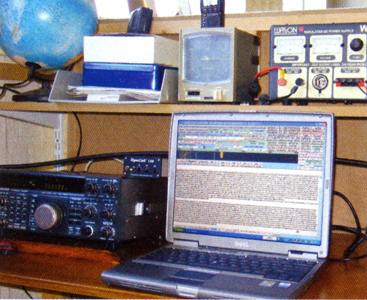
MKARS used modern equipment operated by M0TIF, G32PA, G8GNI and G1RNZ. Their better aerials gave improved signals.
On 15 November, propagation between Paderborn and Bletchley was very poor. Despite trying 20 m and 40 m, useable signals were not received until late into the afternoon. The Y station had been unable to receive any of the transmissions with sufficient accuracy to be of use by the Colossus team. However, the Milton Keynes Amateur Radio Society had set up a 'fall-backb receiving station - GBZBP - consisting of modern transceivers and a laptop running a version of the multi-PSK software written and specially modified by Patrick, F6CTE. This printed on screen all the control characters, rather than acting upon them, thereby providing an accurate representation of the RTTY transmission. The received data was fed into Colossus on the morning of 16 November, and it rendered a solution in a little under four hours - about the same time as it would have managed during the war. Unfortunately for the Bletchley team Joachim Schuth, DLZKCD, received good signals from DLOHNF early in the day, enabling him to use his own specially-written software to beat Bletchleybs time.
Awesome
Colossus is an amazing sight today, but must have been even more so in its day, for l understand the most complex device in the world then had only 150 valves. Walking right into the middle of the beast, surrounded by glowing filaments and the various noises of its operation, l felt very humbled, knowing that I was standing in the centre of what was once the most secret machine in the most secret place in all of wartime England. Thanks to the work of Tony Sale and his team, it has been made to work once more.
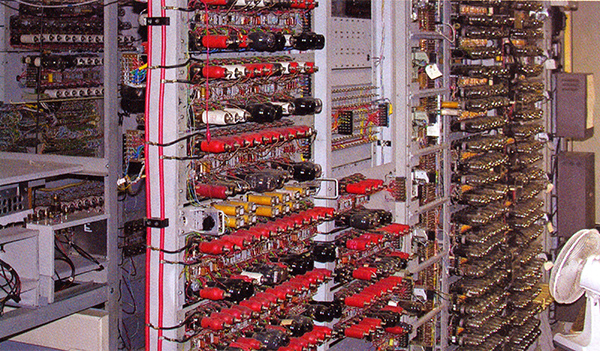
Some of the circuitry at the back of the rear panel. The fan cools the bank of 501 thyratrons used to simulate the Lorenz wheels. The vertical red wires on the left rack are the heater busbars.
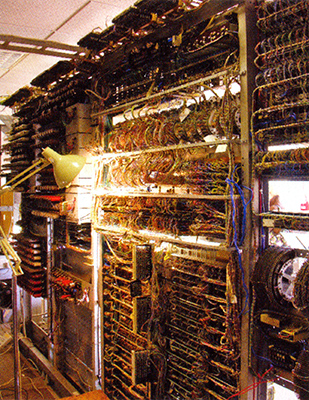
Just some of the wiring behind the front panel.
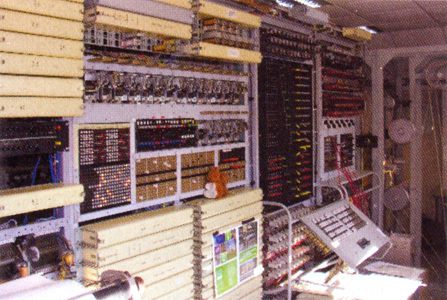
Colossus front rack. The teletype is at the bottom left The 'bedstead' tape reader is on the right, and the remainder of the front panel is largely taken up with switches and other controls. The white bars conceal rows of relays which click like a heartbeat.
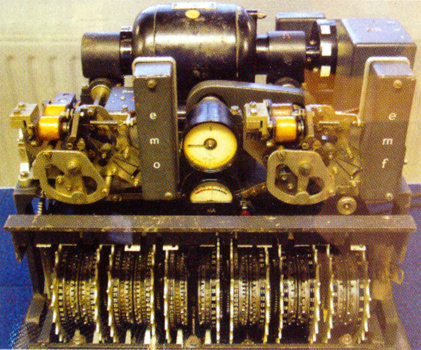
The Lorenz S42 cipher machine, whose encryption was broken by Colossus.
|